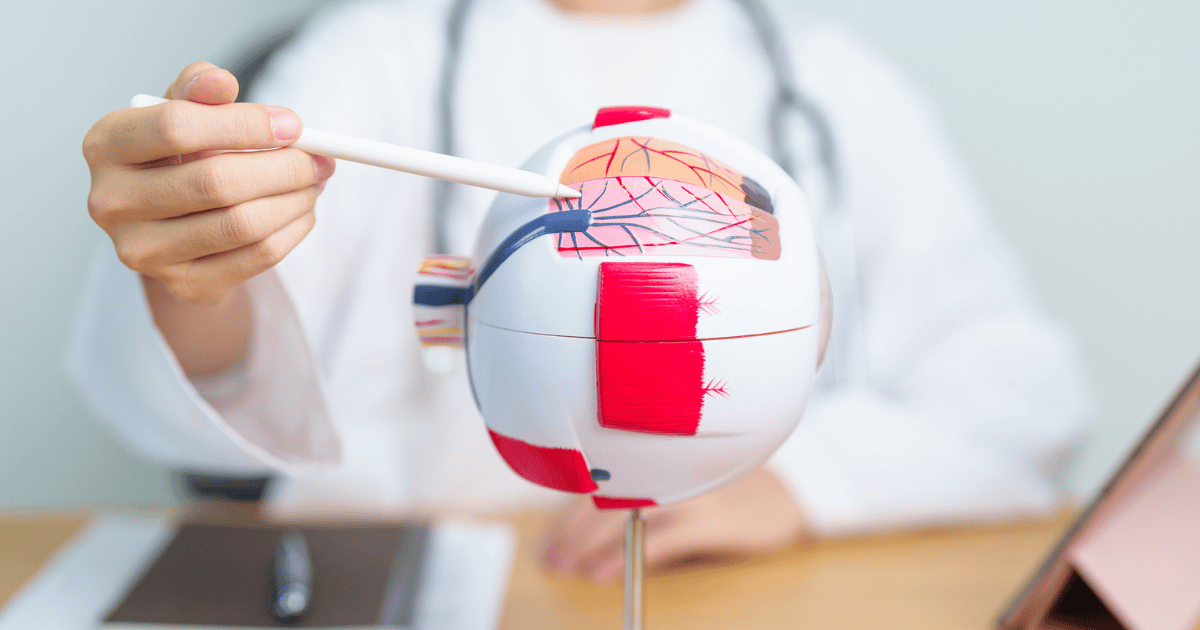The Hidden Ways Diabetes Affects Eye Health
November 6, 2025
Diabetes does not just affect the retina (like in retinopathy). High blood sugar and insulin resistance put stress on the tiny blood vessels and nerves throughout your eyes. These changes increase your risk for several diabetic eye diseases.
Some people notice blurry vision or trouble focusing, while others may not see any warning signs until the damage is more advanced. These early changes in the eye also set the stage for other complications that develop more quickly and severely in people with diabetes.
That is why eye health with diabetes is about more than just retinopathy. It can affect your entire visual system. Catching these problems early allows for treatment that slows or prevents serious vision loss.

Diabetic Cataracts
People with diabetes are more likely to develop cataracts at an earlier age. High blood sugar changes the proteins inside the eye’s lens, causing it to become cloudy faster than normal. This cloudiness blocks light, making it harder for your eye to focus.
The symptoms usually build up slowly. You might notice:
- Blurry vision that does not clear up with glasses.
- Glare or halos around lights, especially at night.
- Reduced contrast, making it harder to see details in low light.
Cataracts make daily tasks like reading, driving, or recognizing faces more difficult. Left untreated, they significantly affect your ocular health and quality of life.
The good news is that cataract surgery is highly effective. During surgery, the cloudy lens is replaced with a clear artificial one, restoring sharper vision. Alongside treatment, maintaining stable blood sugar levels helps slow the growth of future cataracts and lowers the risk of other diabetic eye diseases.
Diabetes and Glaucoma
Glaucoma is a condition that damages the optic nerve, often due to increased pressure inside the eye.
People with diabetes are at a higher risk because high blood sugar can change how fluid drains within the eye. Over time, this buildup of fluid increases intraocular pressure, which harms the nerve fibers that send visual information to the brain.
In its early stages, glaucoma often develops without noticeable symptoms. Many people do not realize there is a problem until peripheral vision begins to fade. Without treatment, the damage can lead to significant and permanent vision loss.
Common signs of advancing glaucoma include:
- Gradual loss of side vision or “tunnel vision.”
- Blurry vision or eye discomfort.
- Halos around lights, especially at night.
Regular eye exams are crucial for detecting changes early. If detected in time, treatments such as eye drops, laser therapy, or surgery can lower intraocular pressure and slow the disease’s progress.
Diabetic Macular Edema (DME)
Diabetic macular edema happens when damaged blood vessels in the retina leak fluid into the macula (the part of the eye that controls sharp, central vision). As the macula swells, it becomes harder to see fine details clearly. Without treatment, this swelling can lead to permanent loss of central vision.
Common symptoms include:
- Distorted vision, where straight lines may appear wavy.
- Trouble reading small print or focusing on close tasks.
- Difficulty recognizing faces, even at a short distance.
DME is one of the most serious forms of diabetic eye disease because it directly affects your ability to read, drive, or work.
Treatment typically involves anti-VEGF injections, which block the growth of abnormal blood vessels and help reduce swelling. Laser therapy may also be used to seal leaking vessels. Both options can stabilize or improve vision when started early.
Other Eye Health Concerns Linked to Diabetes
Diabetes affects more than the major eye diseases like cataracts, glaucoma, and macular edema. It also increases your risk for other eye problems that impact comfort and recovery.
- Infections and dry eye: High blood sugar can weaken your body’s defenses, making infections more likely. Diabetes is also linked to dry eye, which causes irritation, redness, and burning.
- Slower healing: If you require eye surgery, diabetes can prolong your recovery. Wounds may take longer to close, and the risk of complications is higher.
- Neuropathy and ocular nerves: Just as diabetes can damage nerves in the hands and feet, it can also affect the nerves that control eye movement and focus. This may lead to double vision or difficulty tracking objects.
Preventing Vision Loss from Diabetes

The best way to protect your vision with diabetes is to stay ahead of the damage.
Consistent glucose management reduces stress on the blood vessels and nerves in your eyes. Maintaining a healthy blood sugar level within a normal range reduces the risk of diabetic eye disease and helps preserve long-term quality of life.
Regular screenings are just as important. Most people with diabetes should have a comprehensive eye examination at least once a year.
During this visit, your eye doctor will check for changes in the retina, measure intraocular pressure, and look for early signs of cataracts, glaucoma, diabetic macular edema, or other potential problems. Catching these changes early makes treatment more effective.
Healthy lifestyle habits also help prevent vision loss. Eating a balanced diet, exercising regularly, not smoking, and managing blood pressure all play a role in protecting your eyes.
Together with professional care, these steps provide the best opportunity for maintaining your vision for years to come.
Protecting Your Eyes Beyond Retinopathy
If you have diabetes, do not wait until symptoms appear. Schedule a comprehensive diabetic eye exam or call us at (512) 213-2220 to help safeguard your sight and keep your eyes healthy.
Our eye care team serves Dripping Springs, Austin, Kyle, Bee Cave, Marble Falls, and other surrounding areas.


